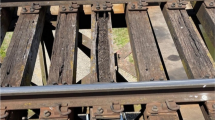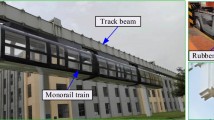Abstract
Turnout is the essential track equipment to achieve train switching. To ensure a safe and stable railway operation, it is significant to carry out scientific tamping operations in the turnout areas. However, the tamping operation parameters of the large machine in the turnout areas are complex and diverse. The daily maintenance is mainly based on experience. In order to enhance the effectiveness of field maintenance operations, based on the DEM-MBD coupling algorithm, a simulation model of the tamping device-sleeper-ballast bed in the turnout areas was established and analyzed. The ballast material used is granite, commonly used in China, and the ballast particle gradation is the first-grade ballast commonly used in China's mainline railway and turnout areas. The correctness of the model was verified by field tests. On this basis, the influence of vibration frequency and amplitude on the tamping operation of the ballast bed in turnout areas is analyzed in detail from both macro and micro perspectives. Based on the response surface analysis method, parameter optimization suggestions are given. The results show that the vibration frequency significantly affects the vertical contact state of the particles, and the amplitude of the tamping device has a considerable influence on the contact state of particles along the line. The support stiffness of the ballast bed initially increases and later decreases with an increase in vibration frequency and amplitude. It is observed that tamping device amplitude has a greater influence on the support stiffness of the ballast bed than vibration frequency.






















Similar content being viewed by others
References
Wang R, Jing G, Wang B et al (2023) Under ballast mat–a review of recent developments, limitations, and future prospect. Proc Inst Mech Eng Part F J Rail Rapid Transit 09544097221150494
Maramizonouz S, Nadimi S, Skipper WA et al (2023) Numerical modelling of particle entrainment in the wheel–rail interface. Comput Part Mech 1–11
Guo Y, Markine V, Song J et al (2018) Ballast degradation: effect of particle size and shape using Los Angeles Abrasion test and image analysis. Constr Build Mater 169:414–424
Ma X, Zi H, Liu C et al (2022) Study of problems related to Laying ballastless track in the turnout of ballasted track at high-speed railway stations. Adv Mater Sci Eng 2022:1–16
Guo Y, Markine V, Jing G (2021) Review of ballast track tamping: mechanism, challenges and solutions. Constr Build Mater 300:123940
Zhang Z, Xiao H, Zhu Y et al (2022) Macro–meso mechanical properties of ballast bed during three-sleeper tamping operation. Int J Rail Transp 1–26
McDowell GR, Lim WL, Collop AC et al (2005) Laboratory simulation of train loading and tamping on ballast. Proc Inst Civ Eng Transp 158(2):89–95
Aingaran S, Pen L, Zervos A et al (2018) Modelling the effects of trafficking and tamping on scaled railway ballast in triaxial tests. Transp Geotech 15:84–90
Aursudkij B (2007) A laboratory study of railway ballast behaviour under traffic loading and tamping maintenance. University of Nottingham, Nottingham
Descantes Y, Perales R, Saussine G et al (2011) On the damaging effects of the ballast tamping operation. In: AIPCR
Douglas SC (2013) Railroad ballast quality and break down during tamping. Indianapolis
Wang W, Song S, Yan H et al (2018) Experimental study on resistance characteristics of ballast bed in different stamping stages. J Cent South Univ (Sci Technol) 49(08):2003–2008
Liu J, Wang P, Liu G et al (2019) Influence of a tamping operation on the vibrational characteristics and resistance-evolution law of a ballast bed. Constr Build Mater 239:117879
Deiros I, Voivret C, Combe G et al (2016) Quantifying degradation of railway ballast using numerical simulations of micro-deval test and in-situ conditions. Procedia Eng 143:1016–1023
Kim DS, Hwang SH, Kono A et al (2018) Evaluation of ballast compactness during the tamping process by using an image-based 3D discrete element method. Proc Inst Mech Eng Part F J Rail Rapid Transit 232(7):1951–1964
Gao L, Shi S, Zhong Y et al (2023) Real-time evaluation of mechanical qualities of ballast bed in railway tamping maintenance. Int J Mech Sci 248:108192
Shi S, Gao L, Cai X et al (2020) Effect of tamping operation on mechanical qualities of ballast bed based on DEM-MBD coupling method. Comput Geotech 124:103574
Boler H, Mishra D, Tutumluer E et al (2019) Stone blowing as a remedial measure to mitigate differential movement problems at railroad bridge approaches. Proc Inst Mech Eng Part F J Rail Rapid Transit 233(1):63–72
Wang Y, Xiao H, Ling X et al (2022) 2D ballast particle contour generation based on the random midpoint displacement algorithm. Comput Part Mech 10:1–17
DEM Hossain Z (2007) analysis of angular ballast breakage under cyclic loading. Geomech Geoeng 2(3):175–181
Zhang Z, Zhang X, Qiu H et al (2016) Dynamic characteristics of track-ballast-silty clay with irregular vibration levels generated by high-speed train based on DEM. Constr Build Mater 125:564–573
Lu M, McDowell GR (2007) The importance of modelling ballast particle shape in the discrete element method. Granul Matter 9:69–80
Kumara JJ, Hayano K (2016) Importance of particle shape on stress-strain behaviour of crushed stone-sand mixtures. Geomech Eng 10(4):455–470
Aela P, Zong L, Yin ZY et al (2023) Calibration method for discrete element modeling of ballast particles. Comput Part Mech 10(3):481–493
Mahmoud E, Papagiannakis AT, Renteria D (2016) Discrete element analysis of railway ballast under cycling loading. Procedia Eng 143:1068–1076
Chen C, Indraratna B, McDowell G et al (2015) Discrete element modelling of lateral displacement of a granular assembly under cyclic loading. Comput Geotech 69:474–484
Zhang X, Zhao C, Zhai W (2017) DEM analysis of ballast breakage under train loads and its effect on mechanical behaviour of railway track. In: Proceedings of the 7th international conference on discrete element methods. Springer, Singapore, pp 1323–1333
Lane JE, Metzger PT, Wilkinson RA (2010) A review of discrete element method (DEM) particle shapes and size distributions for lunar soil
Neto AG, Wriggers P (2022) Discrete element model for general polyhedra. Comput Part Mech 9:1–28
Santasusana M, Irazábal J, Oñate E et al (2016) The Double Hierarchy Method. A parallel 3D contact method for the interaction of spherical particles with rigid FE boundaries using the DEM. Comput Part Mech 3:407–428
Nassauer B, Kuna M (2015) Impact of micromechanical parameters on wire sawing: a 3D discrete element analysis. Comput Part Mech 2:63–71
Alonso-Marroquin F, Wang Y (2009) An efficient algorithm for granular dynamics simulation with complex-shaped objects. Granul Matter 11(5):317–329
Eliáš J (2014) Simulation of railway ballast using crushable polyhedral particles. Powder Technol 264:458–465
Ahmed S, Harkness J, Le Pen L et al (2016) Numerical modelling of railway ballast at the particle scale. Int J Numer Anal Methods Geomech 40(5):713–737
Zhang Z, Xiao H, Wang Y et al (2023) Numerical simulation of the three-sleeper asynchronous tamping operation of ballast bed based on the virtual unit module and polyhedral ballast model. Transp Geotech 40:100964
Tutumluer E, Qian Y, Hashash YMA et al (2013) Discrete element modelling of ballasted track deformation behaviour. Int J Rail Transp 1(1–2):57–73
Rao C, Tutumluer E, Stefanski JA (2001) Coarse aggregate shape and size properties using a new image analyzer. J Test Eval 29(5):461–471
Moaveni M, Wang S, Hart J (2013) Size and shape by means evaluation of aggregate of segmentation techniques and aggregate image algorithms processing. Transp Res Rec 2335:50–59
Saussine G, Cholet C, Gautier PE et al (2006) Modelling ballast behaviour under dynamic loading. Part 1: a 2D polygonal discrete element method approach. Comput Methods Appl Mech Eng 195(19–22):2841–2859
Jiang MJ, Yu HS, Harris D (2005) A novel discrete model for granular material incorporating rolling resistance. Comput Geotech 32(5):340–357
Irazábal J, Salazar F, Oñate E (2017) Numerical modelling of granular materials with spherical discrete particles and the bounded rolling friction model. Application to railway ballast. Comput Geotech 85:220–229
Indraratna B, Ngo NT, Rujikiatkamjorn C et al (2014) Behavior of fresh and fouled railway ballast subjected to direct shear testing: discrete element simulation. Int J Geomech 14(1):34–44
Huang H, Tutumluer E (2011) Discrete element modeling for fouled railroad ballast. Constr Build Mater 25(8):3306–3312
Sakaguchi H, Ozaki E, Igarashi T (1993) Plugging of the flow of granular materials during the discharge from a silo. Int J Mod Phys B 7(09n10):1949–1963
Ai J, Chen JF, Rotter JM et al (2011) Assessment of rolling resistance models in discrete element simulations. Powder Technol 206(3):269–282
Zhai W, Wang K, Cai C (2009) Fundamentals of vehicle–track coupled dynamics. Veh Syst Dyn 47(11):1349–1376
Zhai W, Wang Q, Lu Z et al (2001) Dynamic effects of vehicles on tracks in the case of raising train speeds. Proc Inst Mech Eng Part F J Rail Rapid Transit 215(2):125–135
Jing G, Zhang X, Jia W (2019) Lateral resistance of polyurethane-reinforced ballast with the application of new bonding schemes: laboratory tests and discrete element simulations. Constr Build Mater 221:627–636
Zhou P, Li Y, Liang R et al (2023) Calibration of contact parameters for particulate materials in residual film mixture after sieving based on EDEM. Agriculture 13(5):959
Rothenburg L, Bathurst RJ (1989) Analytical study of induced anisotropy in idealized granular materials. Geotechnique 39(4):601–614
O’sullivan C, Cui L, O’neill SC (2008) Discrete element analysis of the response of granular materials during cyclic loading. Soils Found 48(4):511–530
Asadzadeh M, Soroush A (2016) Fundamental investigation of constant stress simple shear test using DEM. Powder Technol 292:129–139
Xiao H, Fang J, Chi Y et al (2022) Discrete element analysis of the effect of manual tamping operation on the mechanical properties of ballast bed. Constr Build Mater 361:129557
Guo Y, Jia W, Markine V et al (2021) Rheology study of ballast-sleeper interaction with particle image Velocimetry (PIV) and discrete element modelling (DEM). Constr Build Mater 282:122710
Gu Q, Liu H, Wu Y et al (2022) Evolution of trackbed performance and ballast degradation due to passages of million train wheel axle loads. Transp Geotech 34:100753
Tong Y, Liu G, Yousefian K et al (2022) Track vertical stiffness—value, measurement methods, effective parameters and challenges: a review. Transp Geotech 37:100833
Xiao J, Liu G, Liu J et al (2019) Parameters of a discrete element ballasted bed model based on a response surface method. J Zhejiang Univ Sci A (Appl Phys Eng) 20(9):685–700
Kim SH, Na SW (1997) Response surface method using vector projected sampling points. Struct Saf 19(1):3–19
Bar-Gera H (2017) The target parameter of adjusted r-squared in fixed-design experiments. Am Stat 71(2):112–119
Acknowledgements
The authors gratefully acknowledge the project supported by the National Natural Science Foundation of China (Grant Number 51978045) and the Fundamental Research Funds for the Central Universities (Science and technology leading talent team project) (Grant Number 2022JBXT010).
Author information
Authors and Affiliations
Contributions
YC: conceptualization, methodology, formal analysis, writing—original draft. HX: Conceptualization, project administration, funding acquisition, supervision. ZZ: Formal analysis, validation, software, data curation. MMN: writing—review and editing. ZQ: software, data curation.
Corresponding author
Ethics declarations
Competing interest
The authors declare that they have no known competing financial interests or personal relationships that could have appeared to influence the work reported in this paper.
Additional information
Publisher's Note
Springer Nature remains neutral with regard to jurisdictional claims in published maps and institutional affiliations.
Rights and permissions
Springer Nature or its licensor (e.g. a society or other partner) holds exclusive rights to this article under a publishing agreement with the author(s) or other rightsholder(s); author self-archiving of the accepted manuscript version of this article is solely governed by the terms of such publishing agreement and applicable law.
About this article
Cite this article
Chi, Y., Xiao, H., Zhang, Z. et al. Analysis of the influence of vibration frequency and amplitude on ballast bed tamping operation in railway turnout areas. Comp. Part. Mech. 11, 771–788 (2024). https://doi.org/10.1007/s40571-023-00652-4
Received:
Revised:
Accepted:
Published:
Issue Date:
DOI: https://doi.org/10.1007/s40571-023-00652-4




